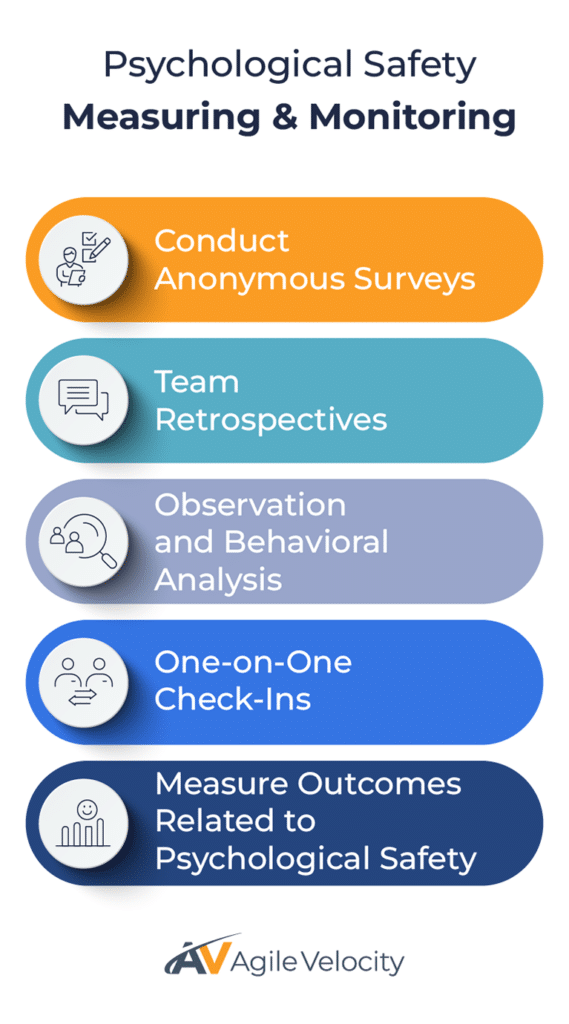In the ever-changing landscape of Agile, teams must adapt quickly, take risks, and engage in open collaboration. Achieving these outcomes hinges on a less visible but crucial factor: Psychological Safety.
Psychological safety refers to the shared belief that team members can express ideas, ask questions, or admit mistakes without fear of ridicule or retaliation.
For Agile teams, where innovation, transparency, and continuous improvement are cornerstones, fostering psychological safety is not just a nice-to-have—it’s essential. Here’s why it matters and how teams can cultivate it.
Why Psychological Safety Matters in Agile
1. Encourages Open Communication
Agile frameworks, thrive on open dialogue. Whether it’s during sprint planning, retrospectives, or daily stand-ups, team members need the freedom and empowerment to voice their thoughts without hesitation. Psychological safety ensures that diverse ideas are welcomed, fostering creativity and innovative problem-solving.
2. Supports Risk-Taking and Experimentation
Agile emphasizes iterative processes and experimentation. To test new ideas and learn from failures, team members must feel safe taking risks. When psychological safety is present, mistakes are seen as opportunities to learn, not causes for blame.
3. Promotes Accountability and Ownership
Psychological safety empowers team members to take ownership of their work. When individuals know they can admit errors or seek help without fear of judgment, they’re more likely to proactively address challenges, enhancing accountability across the team.
4. Drives Continuous Improvement
Retrospectives are vital in Agile, providing a space to reflect and improve. However, these sessions are only effective if team members feel comfortable discussing what didn’t go well. Psychological safety enables candid feedback, paving the way for genuine improvement.
Build High-Performing Teams
Building Psychological Safety in Agile Teams
1. Model Vulnerability as a Leader
Leaders and Scrum Masters set the tone for psychological safety. By being vulnerable to their own learning moment and encouraging feedback, they create an environment where it’s safe for others to do the same.
2. Normalize Feedback and Constructive Criticism
Feedback should be framed as a tool for growth, not a means of criticism. Agile teams can use practices like “Start, Stop, Continue” to foster constructive discussions that focus on behavior rather than personality.
3. Foster a Culture of Inclusivity
Psychological safety thrives in inclusive environments. Ensure every team member has a voice, whether through structured facilitation techniques like round-robin discussions or by explicitly inviting quieter members to share their thoughts, while also accepting that some team members may not be comfortable speaking out. For those, allow yourself to be creative with facilitation, allowing space for non-verbal communication.
4. Focus on Team Dynamics
Building trust is key to psychological safety. Team-building activities, shared goals, and celebrating successes together can strengthen bonds and encourage mutual respect.
5. Address Toxic Behaviors Immediately
Psychological safety can be undermined by toxic behaviors, such as dismissiveness or blame-shifting. Leaders must identify and address these behaviors immediately to maintain a healthy team environment. For example: Look for signs of toxic behaviors, such as:
- Negative Communication Patterns: Frequent sarcasm, criticism, or blame shifting.
- Resistance to Feedback: Dismissing constructive feedback or becoming defensive
- Lack of Accountability: Avoiding responsibility and or blaming others when problems arise.
Measuring and Monitoring Psychological Safety


1. Conduct Anonymous Surveys
Surveys are an effective way to gather honest feedback. Use simple tools like Google Forms, or Microsoft Forms to create anonymous assessments. Key questions to include:
- “Do you feel safe expressing your thoughts and opinions in the team?”
- “Can you admit mistakes without fear of negative consequences?”
- “Do you feel your contributions are valued by the team?”
- “Are team conflicts addressed constructively?”
Tip: Use a Likert scale (e.g., 1 = Strongly Disagree, 5 = Strongly Agree) to quantify responses and track changes over time.
2. Team Retrospectives
Use retrospectives to gauge psychological safety indirectly. For example:
- Conduct a “Safety Check” at the start: Ask team members to rate their current feeling of safety on a scale of 1 to 5.
- Use facilitation techniques like “Rose, Thorn, Bud” or “Mad, Sad, Glad” to encourage open conversations about team dynamics and interactions.
Tip: Observe the level of participation and the willingness to share during retrospectives as a proxy for psychological safety. A team with low safety may rank themselves all as a 5 on the scale, but the behavior during the retrospective could indicate the true status.
3. Observation and Behavioral Analysis
Psychological safety can often be assessed by observing team interactions:
- Are meetings dominated by a few voices, or is participation balanced?
- Do team members interrupt or dismiss others’ ideas?
- Are conflicts resolved respectfully, or do they create tension?
Tip: Leaders and Scrum Masters should observe these dynamics and keep a log of behaviors that indicate a lack of psychological safety, such as blame-shifting or hesitation to speak.
4. One-on-One Check-Ins
Regular one-on-one conversations provide a safe space for individuals to share concerns they might not voice in a group. Ask open-ended questions like:
- “Do you feel comfortable raising concerns in team meetings?”
- “What’s one thing that could make our team environment better for you?”
- “Have there been situations where you hesitated to speak up? Why?”
Tip: Act on the feedback provided to show you value their input, which further strengthens psychological safety. Whenever possible, have another outside source of truth for the team. For example, once a quarter is there a Scrum Master who could do a 1:1 with each team member, to ensure they have a route to voice concerns?
5. Measure Outcomes Related to Psychological Safety
Although harder to quantify directly, psychological safety often correlates with other measurable outcomes:
- Innovation rate: Frequency of new ideas being implemented.
- Feedback loops: How often feedback is given and acted upon.
- Error reporting: Number of openly reported mistakes or process improvements.
- Team engagement: Participation levels in meetings and retrospectives.
Tip: If these metrics show improvement alongside efforts to enhance psychological safety, it’s a good indication that your interventions are working.
The Impact of Psychological Safety on Performance
Psychological Safety is a critical factor that significantly influences team performance, especially in Agile environments. When team members feel safe to express themselves without fear of being ridiculed or judged, or even punished, it creates a foundation for collaboration, innovation and productivity. It impacts performance in measurable and meaningful ways:
1. Enhances Innovation and Creativity
- Encourages Risk-Taking: Psychological safety allows team members to propose unconventional ideas without fear of criticism. This fosters innovation, as individuals feel confident experimenting with new solutions.
- Improves Problem-Solving: When diverse perspectives are openly shared, teams are better equipped to tackle complex challenges.
2. Boosts Collaboration and Communication
- Promotes Open Dialogue: Team members are more likely to share information, ask questions, and seek clarification, reducing misunderstandings and misalignment.
- Strengthens Trust: When psychological safety is present, individuals trust each other to engage respectfully, even during conflicts, leading to healthier team dynamics.
3. Improves Decision-Making
- Reduces Groupthink: Psychological safety encourages dissenting opinions, ensuring that decisions are robust and well-considered.
- Speeds Up Learning Cycles: Teams can discuss failures without fear, allowing them to adapt and improve continuously.
4. Increases Accountability and Ownership
- Encourages Proactive Behavior: Team members feel empowered to take responsibility for their work, even if they encounter challenges.
- Builds Resilience: Individuals are more willing to admit mistakes and collaborate to find solutions, fostering a sense of accountability.
5. Reduces Stress and Burnout
- Creates a Supportive Environment: When individuals feel safe, they are less likely to experience workplace stress and anxiety.
- Fosters Work-Life Balance: Teams with psychological safety often exhibit higher emotional intelligence, creating a culture of understanding and mutual support.
Embrace Psychological Safety
Psychological safety is the bedrock of Agile success. It transforms teams into cohesive, resilient units capable of tackling complex challenges with confidence and creativity. By prioritizing psychological safety, Agile teams not only enhance their performance but also create a workplace where individuals feel valued and empowered to do their best work.
Embrace psychological safety—not as an abstract ideal, but as a tangible goal that drives better collaboration, stronger outcomes, and a more fulfilling Agile journey.



